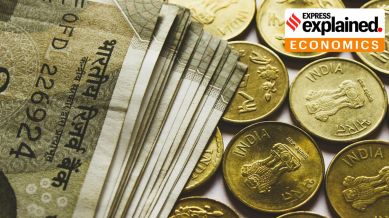RBI $10 bn buy-sell swap: how it could boost liquidity, curb volatility, beef up dollar reserves
The central bank's initiative is designed to provide a durable solution to the system's liquidity requirements, while also stabilising the value of the rupee and bolstering the nation's foreign exchange kitty. Here is what to know.

After conducting a $5 billion dollar-rupee swap less than a month ago, the Reserve Bank of India (RBI) on Friday (February 21) decided to inject rupee liquidity for longer duration through another $10 billion dollar-rupee buy-sell swap arrangement. The central bank’s initiative is designed to provide a durable solution to the system’s liquidity requirements, while also stabilising the value of the rupee and bolstering the nation’s foreign exchange kitty.
Why is it being done?
How serious is the liquidity problem?
The Indian banking system encountered its worst liquidity crunch in more than a decade in January 2025. The liquidity deficit peaked at Rs 3.15 lakh crore on January 23, its lowest level in nearly 15 years. As was the case in the preceding month, tax outflows, GST payments and the RBI’s forex interventions to stabilize the rupee and currency in circulation (CIC) outflows significantly impacted cash flows in the banking system. The deficit led to increased dependence by banks on market borrowing, thereby keeping interbank call money rates — rate at which banks lend to each other — consistently above the policy repo rate of 6.50 per cent, according to Crisil.
The RBI has been selling dollars to stabilise the rupee, thereby sucking out an equivalent amount in rupee from the system. RBI’s outstanding net forward sales of the dollar surged to $67.93 billion as of December 31, 2024, as the central bank intensified its efforts to stabilize the rupee. In the spot market, the RBI’s dollar sales stood at $45 billion in the third quarter — $15.15 billion in December 2024, $20.22 billion in November and $ 9.27 billion in October.
How does swap work?
The swap is in the nature of a simple buy-sell foreign exchange swap from the Reserve Bank side. A bank will sell US dollars to the Reserve Bank and simultaneously agrees to buy the same amount of US dollars at the end of the swap period.
In the first leg of the transaction, the bank will sell dollars to the Reserve Bank at FBIL Reference Rate of the auction date. The settlement of the first leg of the swap will take place on spot basis from the date of transaction and the Reserve Bank will credit the rupee funds to the current account of the successful bidder and the bidder needs to deliver dollars into the RBI’s nostro account. In the reverse leg of the swap transaction, rupee funds will have to be returned to the Reserve Bank along with the swap premium to get the dollars back.
What were the RBI measures to meet liquidity so far?
The RBI had infused over Rs 3.6 lakh crore of durable liquidity into the banking system in the last five weeks through debt purchases, forex swaps and longer-duration repos. The central bank resorted to several measures during the course of January to inject liquidity into the system, including several variable rate repo (VRR) auctions of varying tenors and a series of daily VRR auctions conducted between January 16 and January 23. The RBI also announced additional measures, such as a $5 billion dollar-rupee swap on January 31, as well as open market operations (OMO) purchase auctions of government securities aggregating Rs 60,000 crore and a 56-day VRR auction scheduled in February, to help overcome the tightness in liquidity.